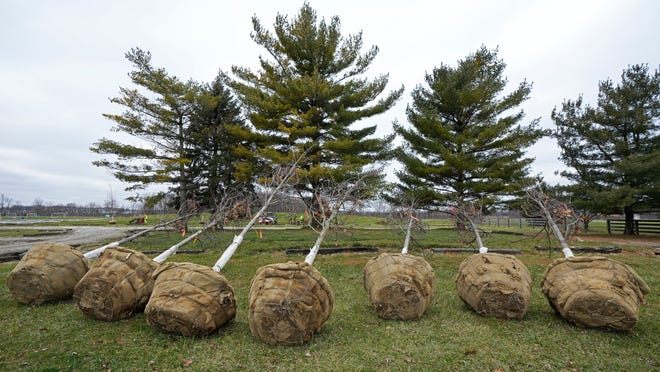A change in Columbus city code now requires trees to be replaced if they are removed from city-owned land or rights-of-way, such as tree lawns next to city streets.
The requirement comes as the city continues to implement its 2021 urban forestry master plan to boost the city’s tree canopy to help reduce heat and utility bills in neighborhoods while providing more pleasant environments.
According to the city, if you remove a public tree, you must make up for the loss of that tree, whether you are a resident, developer or utility.
Tree mitigation can mean replanting or payment into a tree fund at an inch-for-inch rate, meaning for every diameter inch of a public tree that is removed, an equal number of diameter inches must be replanted. That’s different from previous policies.
So if you remove a tree that is 12 inches in diameter, you must replace it with an equivalent amount, such as two 6-inch trees, or four 3-inch trees.
“We want it to be equivalent to what we lost,” said Rosalie Hendon, city senior environmental planner, though Hendon acknowledged that there is no way to make up for the loss of the large tree.
Steve Horhut, city forester, said that arborists will come out for site inspections, checking soil volumes and tree-lawn widths to determine if the tree replacements can work at the site where a tree has been removed, or be planted somewhere else in the neighborhood.
People can also pay a fee if they don’t want to replace a tree. Previously, that fee was $200 a diameter inch. Now it’s $260.
The city doesn’t intend to require mitigation for trees valued at less than $5,000 if a homeowner if facing a hardship, such as an expensive sanitary line replacement, Horhut said.
Anyone planting or pruning a tree in the right-of-way, or potentially impacting a tree because of construction should reach out to the Columbus Recreation and Parks’ Forestry section at 311 or email Forestry@columbus.gov. The forestry section issues permits for those actions, and will determine the required mitigation for each project. Horhut said those wanting to prune trees in the right-of-way need a city permit or file a service request with the city.
Columbus City Council adopted the code changes on Dec. 11. The city will finalize a manual in 2024.
“We knew we wanted to codify tree mitigation,” Hendon said.
That’s because there were some loopholes in city policy where not every tree was replaced, Hendon said.
In December 2015, former Mayor Michael B. Coleman issued an executive order that required tree mitigation for professional services or construction projects on city property or right-of-way that included work that city dollars solely funded.
But that exempted routine maintenance, and projects funded solely with private contributions. so loopholes contributed to tree canopy loss. The new code language closes those loopholes, Horhut said.
Trees can be replanted close to the time of the tree removal, either a spring or fall planting period, said Stephanie Garling, a spokeswoman for the city Recreation and Parks Department.
Not complying with the new code is a third-degree misdemeanor, punishable by up to 60 days in jail and a maximum $500 fine. Horhut said his section would check with the Columbus City Attorney’s office about enforcement.
City Councilmember Emmanuel Remy said with all the work the city put into developing its urban forestry master plan, it’s important that the city leads by example.
“We’ve experienced rapid growth. We need to be intentional preserving our tree canopy,” Remy said.
The city completed its urban forestry master plan in 2021, with the goal of expanding Columbus’ tree canopy to 40% of the city by 2050. Just 22% of the city is covered now, ranging from 9% Downtown and 11% in Italian Village to 13% in the Westland area, 15% in Franklinton and the Southeast Side, and 41% in Clintonville.
In 2022 a report showed that the city’s hottest neighborhoods were those with the fewest trees, the oldest buildings — many without air conditioning — and the poorest residents. Downtown and surrounding neighborhoods, Franklinton, and areas on the West Side had the highest temperatures.
In North Linden, canopy coverage is 28%. Ben Keith, zoning chair of the North Linden Area Commission, said that while that’s better than other neighborhoods, the city needs to do a better job of protecting trees, especially during development.
Keith said he wonders if the city could extend the tree mitigation rules to private properties.
Seattle did just that in 2023, when a protection ordinance for trees on private property took effect. There, the ordinance limits tree removal on properties that are not being redeveloped. It requires that any tree 12 inches or more in diameter that is removed be replaced — even if it is a dangerous tree that must be removed.
Columbus officials want to stop tree canopy loss by 2030. The city plants 3,000 to 4,000 trees a year, budgeting about $400,000 for that, while removing 1,200 to 1,500 that are diseased or knocked down by storms, Hendon said.
In 2022, a study by Columbus-based Scioto Analysis suggested that the economic benefits would outweigh the cost of meeting the 2050 tree canopy goal by $22 million, looking at carbon absorption, stormwater runoff prevention, air pollution reductions, energy savings — even reducing crime.
mferench@dispatch.com
@MarkFerenchik
www.dispatch.com
https://www.dispatch.com/story/news/local/2024/01/04/if-you-remove-a-tree-from-city-of-columbus-property-you-now-have-to-replace-it-or-pay-a-fee/71930519007/













